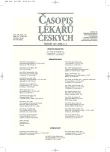Contemporary Prospects for the Diagnostics and Treatment of the Chronic Pulmonary Hypertension
Současné možnosti diagnostiky a léčby chronické plicní hypertenze
Hemodynamicky je plicní hypertenze nově definována jako zvýšení středního tlaku v plicnici nad 25 mmHg v klidu nebo nad 30 mmHg při zátěži a současně zvýšení plicní cévní rezistence nad 3 WU (Woodovy jednotky). Podle poslední klasifikace WHO z roku 2003 je plicní hypertenze dělena na plicní arteriální hypertenzi, plicní žilní hypertenzi, hypoxickou plicní hypertenzi, chronickou tromboembolickou plicní hypertenzi a plicní hypertenzi z jiných příčin. Symptomy plicní hypertenze jsou nespecifické, proto také stanovení diagnózy je často pozdní. Nemocné se zvýšeným rizikem vzniku plicní hypertenze je nutno preventivně echokardiograficky vyšetřovat. Léčba plicní hypertenze je značně komplikovaná a ekonomicky mimořádně náročná. Proto je soustředěna do specializovaných center. O způsobu farmakoterapie plicní arteriální hypertenze rozhoduje test akutní plicní vazodilatace. Pouze nemocní s pozitivním testem (10 % pacientů) jsou indikováni k léčbě blokátory kalciových kanálů. V případě negativního testu je lékem volby ve stadiu NYHA III perorální bosentan, ve stádiu NYHA IV intravenózní epoprostenol. Všichni nemocní s plicní hypertenzí mají být chronicky antikoagulačně léčeni. U nemocných s chronickou tromboembolickou plicní hypertenzí je metodou volby chirurgické odstranění organizovaného trombotického materiálu s vrstvou stěny plicnice (endarterektomie plicnice) po předchozí nejméně tříměsíční antikoagulační léčbě. Centrum pro plicní hypertenzi v Kardiocentru Všeobecné fakultní nemocnice je jediným pracovištěm v ČR, které se kromě komplexní léčby plicní arteriální hypertenze věnuje rovněž chirurgické léčbě chronické tromboembolické plicní hypertenze.
Klíčová slova:
plicní hypertenze, plicní arteriální hypertenze, chronická tromboembolická plicní hypertenze, blokátory kalciových kanálů, bosentan, epoprostenol, antikoagulační léčba, endarterektomie plicnice.
Authors:
P. Jansa 1; M. Aschermann 1; J. Lindner 2; T. Paleček 1; D. Ambrož 1; A. Linhart 1
Authors‘ workplace:
Centrum pro plicní hypertenzi, II. interní klinika kardiologie a angiologie 1. LF UK a VFN, Praha
1; II. chirurgická klinika kardiovaskulární chirurgie angiologie 1. LF UK a VFN, Praha
2
Published in:
Čas. Lék. čes. 2006; 145: 264-268
Category:
Review Article
Overview
Pulmonary hypertension is defined as the rise of mean pressure in the pulmonary artery over 25 mmHg at rest or over 30 mmHg during activity with accompanying increase of pulmonary vascular resistance over 3 WU (Wood’s unit). According to the recent WHO classification from 2003 pulmonary hypertension can be categorized as pulmonary arterial hypertension, pulmonary venous hypertension, hypoxic pulmonary hypertension, chronic thromboembolic pulmonary hypertension and pulmonary hypertension from other causes. Because symptoms of the pulmonary hypertension are non-specific, the diagnosis is frequently late. Patients with higher risk of pulmonary hypertension require frequent echocardiographic examination. Treatment of the pulmonary hypertension is rather complex and economically demanding. It should be therefore centralized in specialized units. Decision on the pharmacotherapy is based on the acute pulmonary vasodilatation test. Only patients with the positive test (10% of patients) are indicated to the treatment with calcium channel blockers. In case of negative test, the treatment of choice in NYHA III stadium is bosentam per orally, in the NYHA IV stadium it is epoprostenol intravenously. In patients with chronic thromboembolic pulmonary hypertension, organized thrombotic material should be surgically removed together with the layer of the pulmonary artery (pulmonary endarterectomy) after preceding anticoagulation treatment lasting at least three months. Pulmonary hypertension center of the Cardiocenter of the General teaching hospital is the only unit in the Czech Republic which beside the complex therapy of the pulmonary arterial hypertension can employ also the surgical treatment of the chronic thromboembolic pulmonary hypertension.
Key words:
pulmonary hypertension, pulmonary arterial hypertension, chronic thromboembolic pulmonary hypertension, calcium channel blockers, bosentam, epoprostenol, anticoagulation treatment, pulmonary endarterectomy.
Labels
Addictology Allergology and clinical immunology Angiology Audiology Clinical biochemistry Dermatology & STDs Paediatric gastroenterology Paediatric surgery Paediatric cardiology Paediatric neurology Paediatric ENT Paediatric psychiatry Paediatric rheumatology Diabetology Pharmacy Vascular surgery Pain management Dental HygienistArticle was published in
Journal of Czech Physicians

- Metamizole at a Glance and in Practice – Effective Non-Opioid Analgesic for All Ages
- Metamizole vs. Tramadol in Postoperative Analgesia
- The Importance of Limosilactobacillus reuteri in Administration to Diabetics with Gingivitis
- The Importance of Hydration in Wound Healing
Most read in this issue
- Purkynje Fibers of the Heart Conduction System – History and the Present Time
- Larva migrans cutanea
- Pulmonary Endarterectomy – The Surgical Treatment of Chronic Thromboembolic Pulmonary Hypertension
- Long-lasting Cardiostimulation in the Treatment of Heart Failure
